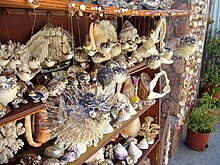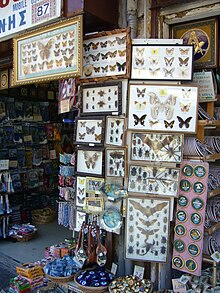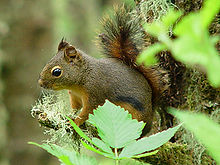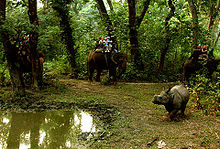Wildlife
This articleneeds additional citations forverification.(October 2021) |

Wildliferefers toundomesticatedanimalspecies,but has come to include allorganismsthat grow or livewild in an areawithout beingintroducedbyhumans.[1]Wildlife was also synonymous togame:thosebirdsandmammalsthat werehunted for sport.Wildlife can be found in allecosystems.Deserts,plains,grasslands,woodlands,forests,and other areas including the most developedurban areas,all have distinct forms of wildlife. While the term inpopular cultureusually refers to animals that are untouched by human factors, most scientists agree that much wildlife isaffectedbyhuman activities.[2]Some wildlife threaten human safety, health, property andquality of life.However, many wild animals, even the dangerous ones, have value to human beings. This value might be economic, educational, or emotional in nature.
Humans have historically tended to separatecivilizationfrom wildlife in a number of ways, including the legal, social and moral senses. Some animals, however, haveadaptedtosuburbanenvironments. This includessuch animalsasferal cats,dogs, mice, and rats. Some religions declare certain animals to be sacred, and in modern times, concern for thenatural environmenthas provokedactiviststo protest against the exploitation of wildlife for human benefit or entertainment.
Global wildlife populations have decreased by 68% since 1970 as a result of human activity, particularlyoverconsumption,population growth,andintensive farming,according to a 2020World Wildlife Fund'sLiving Planet Reportand theZoological Society of London'sLiving Planet Indexmeasure, which is further evidence that humans have unleashed asixth mass extinctionevent.[3][4]According toCITES,it has been estimated that annually the international wildlife trade amounts to billions of dollars and it affects hundreds of millions of animal and plant specimen.[5]
Interactions with humans[edit]
Trade[edit]


Wildlife traderefers to the products that are derived from non-domesticatedanimalsorplantsusually extracted from their natural environment or raised under controlled conditions. It can involve the trade of living or dead individuals, tissues such as skins, bones or meat, or other products. Legal wildlife trade is regulated by theUnited Nations'Convention on International Trade in Endangered Species of Wild Fauna and Flora(CITES), which currently has 184 member countries calledParties.[6]Illegal wildlife trade is widespread and constitutes one of the major illegal economic activities, comparable to thetrafficofdrugsandweapons.[7]
Wildlife trade is a seriousconservationproblem, has a negative effect on the viability of many wildlife populations and is one of the major threats to the survival ofvertebratespecies.[8]The illegal wildlife trade has been linked to theemergenceand spread ofnew infectious diseasesin humans, includingemergent viruses.[9][10]Global initiative like the United NationsSustainable Development Goal 15have a target to end the illegal supply of wildlife.[11]For food[edit]

Stone Agepeople andhunter-gatherersrelied on wildlife, both plants and animals, for their food. In fact, some species may have been hunted toextinctionby early human hunters. Today, hunting, fishing, and gathering wildlife is still a significant food source in some parts of the world. In other areas, hunting and non-commercial fishing are mainly seen as asportor recreation. Meat sourced from wildlife that is not traditionally regarded as game is known asbushmeat.The increasing demand for wildlife as a source of traditional food inEast Asiais decimating populations of sharks, primates,pangolinsand other animals, which they believe haveaphrodisiacproperties.
Malaysia is home to a vast array of amazing wildlife. However, illegal hunting and trade poses a threat to Malaysia's natural diversity.
— Chris S. Shepherd[12]
A November 2008 report from biologist and author Sally Kneidel, PhD, documented numerous wildlife species for sale in informal markets along theAmazon River,including wild-caughtmarmosetssold for as little as $1.60 (5 Peruvian soles).[13][self-published source?]Many Amazon species, includingpeccaries,agoutis,turtles,turtle eggs,anacondas,armadillosare sold primarily as food.
Media[edit]

Wildlife has long been a common subject foreducationaltelevision shows.National Geographic Societyspecials appeared onCBSsince 1965, later moving toAmerican Broadcasting Companyand thenPublic Broadcasting Service.In 1963,NBCdebutedWild Kingdom,a popular program featuring zoologistMarlin Perkinsas host. TheBBC natural history unitin theUnited Kingdomwas a similar pioneer, the first wildlife series LOOK presented bySir Peter Scott,was a studio-based show, with filmed inserts.David Attenboroughfirst made his appearance in this series, which was followed by the series Zoo Quest during which he and cameraman Charles Lagus went to many exotic places looking for and filming elusive wildlife—notably theKomodo dragonin Indonesia and lemurs in Madagascar.[14] Since 1984, theDiscovery Channeland its spinoffAnimal Planetin the US have dominated the market for shows about wildlife on cable television, while onPublic Broadcasting Servicethe NATURE strand made by WNET-13 in New York and NOVA by WGBH in Boston are notable. Wildlife television is now a multimillion-dollar industry with specialist documentary film-makers in many countries including UK, US, New Zealand, Australia, Austria, Germany, Japan, and Canada.[citation needed] There are many magazines and websites which cover wildlife includingNational Wildlife Magazine,Birds & Blooms,Birding (magazine),wildlife.netandRanger Rickfor children.
Religion[edit]
Manyanimal species have spiritual significancein different cultures around the world, and they and their products may be used as sacred objects in religious rituals. For example, eagles, hawks and their feathers have great cultural and spiritual value toNative Americansas religious objects. In Hinduism the cow is regarded as sacred.[15]
Muslims conduct sacrifices onEid al-Adha,to commemorate the sacrificial spirit ofIbrāhīm in Islam(Arabic-Abraham) in love ofGod.Camels, sheep, goats may be offered as sacrifice during the three days of Eid.[16]
In Christianity the Bible has a variety of animal symbols, theLambis a famous title of Jesus. In theNew Testamentthe GospelsMark,LukeandJohnhave animal symbols: "Mark is a lion, Luke is a bull and John is an eagle."[17]
Tourism[edit]


Wildlife tourismis an element of many nations' travel industry centered around observation and interaction with local animal and plant life in their natural habitats. While it can includeeco- and animal-friendly tourism,safari huntingand similar high-intervention activities also fall under the umbrella of wildlife tourism. Wildlifetourism,in its simplest sense, is interacting with wild animals in their naturalhabitat,either actively (e.g. hunting/collection) or passively (e.g. watching/photography). Wildlife tourism is an important part of the tourism industries in many countries including many African andSouth Americancountries,Australia,India,Canada,Indonesia,Bangladesh,Malaysia,Sri LankaandMaldivesamong many. It has experienced a dramatic and rapid growth in recent years worldwide and many elements are closely aligned toeco-tourismandsustainable tourism.
According toUnited Nations World Tourism Organization,with an annual growth about 3%, 7% of world tourism industry relates to wildlife tourism.[18]They also estimate that the growth is much more significant in places likeUNESCO World Heritage Sites.[18]Wildlife tourism currently employs 22 million people worldwide directly or indirectly, and contributes more than $ 120 billion to global GDP.[19]As a multimillion-dollar international industry, wildlife tourism is often characterized by the offering of customized tour packages andsafaristo allow close access to wildlife.Suffering[edit]

Wild animal sufferingis thesufferingexperienced by non-human animals living outside of direct human control due to harms, such asdisease,injury,parasitism,starvationandmalnutrition,dehydration,weather conditions,natural disasters,andkillings by other animals,[20][21]as well aspsychological stress.[22]Some estimates indicate that these individual animals make up the vast majority of animals in existence.[23]An extensive amount of natural suffering has been described as an unavoidable consequence ofDarwinian evolution,[24]as well as the pervasiveness ofreproductive strategies,which favor producing large numbers of offspring, with a low amount of parental care and of which only a small number survive to adulthood, the rest dying in painful ways, has led some to argue that suffering dominates happiness in nature.[20][25][26]
The topic has historically been discussed in the context of thephilosophy of religionas an instance of theproblem of evil.[27]More recently, starting in the 19th century, a number of writers have considered the subject from a secular standpoint as a general moral issue, that humans might be able to help prevent.[28]There is considerable disagreement around taking such action, as many believe that human interventions in nature, for this reason, should not take place because of practicality,[29]valuing ecological preservation over the well-being and interests of individual animals,[30]considering any obligation to reduce wild animal suffering implied by animal rights to be absurd,[31]or viewing nature as an idyllic place where happiness is widespread.[25]Some have argued that such interventions would be an example of humanhubris,orplaying God,and use examples of how human interventions, for other reasons, have unintentionally caused harm.[32]Others, includinganimal rightswriters, have defended variants of alaissez-faireposition, which argues that humans should not harm wild animals but that humans should not intervene to reduce natural harms that they experience.[33][34]
Advocates of such interventions argue that animal rights and welfare positions imply an obligation to help animals suffering in the wild due to natural processes. Some have asserted that refusing to help animals in situations where humans would consider it wrong not to help humans is an example ofspeciesism.[21]Others argue that humans intervene in nature constantly—sometimes in very substantial ways—for their own interests and to further environmentalist goals.[35]Human responsibility for enhancing existing natural harms has also been cited as a reason for intervention.[36]Some advocates argue that humans already successfully help animals in the wild, such as vaccinating and healing injured and sick animals, rescuing animals in fires and other natural disasters, feeding hungry animals, providing thirsty animals with water, and caring for orphaned animals.[37]They also assert that although wide-scale interventions may not be possible with our current level of understanding, they could become feasible in the future with improved knowledge and technologies.[38][39]For these reasons, they argue it is important to raise awareness about the issue of wild animal suffering, spread the idea that humans should help animals suffering in these situations, and encourage research into effective measures, which can be taken in the future to reduce the suffering of these individuals, without causing greater harms.[25][35]Loss and extinction[edit]

This subsection focuses onanthropogenicforms of wildlife destruction. The loss of animals from ecological communities is also known asdefaunation.[40]
Exploitationof wild populations has been a characteristic of modern man since our exodus from Africa 130,000 – 70,000 years ago. The rate of extinctions of entire species of plants and animals across the planet has been so high in the last few hundred years that it is widely believed that a sixth great extinction event ( "theHolocene Mass Extinction") is currently ongoing.[41][42][43][44]The 2019Global Assessment Report on Biodiversity and Ecosystem Services,published by theUnited Nations'Intergovernmental Science-Policy Platform on Biodiversity and Ecosystem Services,says that roughly one million species of plants and animals face extinction within decades as the result of human actions.[45][46]Subsequent studies have discovered that the destruction of wildlife is "significantly more alarming" than previously believed, with some 48% of 70,000 monitored animal species experiencing population declines as the result of human industrialization.[47][48]According to a 2023 study published inPNAS,"immediate political, economic, and social efforts of an unprecedented scale are essential if we are to prevent these extinctions and their societal impacts."[49][50]
The four most general reasons that lead to destruction of wildlife include overkill,habitat destructionandfragmentation,impact of introduced species and chains of extinction.[51]
Overkill[edit]
Overkill happens whenever hunting occurs at rates greater than the reproductive capacity of the population is being exploited. The effects of this are often noticed much more dramatically in slow-growing populations such as many larger species of fish. Initially when a portion of a wild population is hunted, an increased availability of resources (food, etc.) is experienced increasing growth and reproduction asdensity dependentinhibition is lowered. Hunting, fishing and so on, have lowered the competition between members of a population. However, if this hunting continues at rate greater than the rate at which new members of the population can reach breeding age and produce more young, the population will begin todecrease in numbers.[52]
Populations that are confined to islands, whether literal islands or just areas of habitat that are effectively an "island" for the species concerned, have also been observed to be at greater risk of dramatic population rise of deaths declines followingunsustainable hunting.
Habitat destruction and fragmentation[edit]

The habitat of any given species is considered its preferred area orterritory.Many processes associated with human habitation of an area cause loss of this area and decrease the carrying capacity of the land for that species. In many cases these changes in land use cause a patchy break-up of the wild landscape. Agricultural land frequently displays this type of extremely fragmented, or relictual habitat. Farms sprawl across the landscape with patches of uncleared woodland or forest dotted in-between occasional paddocks.
Examples of habitat destruction include grazing of bushland by farmed animals, changes to natural fire regimes, forest clearing for timber production and wetland draining for city expansion.
Impact of introduced species[edit]
Mice, cats, rabbits, dandelions andpoison ivyare all examples of species that have become invasive threats to wild species in various parts of the world. Frequently species that are uncommon in their home range become out-of-control invasions in distant but similar climates. The reasons for this have not always been clear andCharles Darwinfelt it was unlikely that exotic species would ever be able to grow abundantly in a place in which they had not evolved. The reality is that the vast majority of species exposed to a new habitat do not reproduce successfully. Occasionally, however, some populations do take hold and after a period of acclimation can increase in numbers significantly, having destructive effects on many elements of the native environment of which they have become part.
Chains of extinction[edit]
This final group is one of secondary effects. All wild populations of living things have many complex intertwining links with other living things around them. Largeherbivorousanimals such as the hippopotamus have populations ofinsectivorousbirds that feed off the many parasitic insects that grow on the hippo. Should the hippo die out, so too will these groups of birds, leading to further destruction as other species dependent on the birds are affected. Also referred to as adomino effect,this series ofchain reactionsis by far the most destructive process that can occur in anyecological community.
Another example is theblack drongosand thecattle egretsfound in India. These birds feed on insects on the back of cattle, which helps to keep them disease-free. Destroying the nesting habitats of these birds would cause a decrease in the cattle population because of the spread of insect-borne diseases.
See also[edit]
- Do not feed the animals
- Endangered species
- Ex situ conservation
- In situ conservation
- Wildlife corridor
- Wildness
- World Wildlife Day
- Urban wildlife
References[edit]
- ^Usher, M. B. (1986).Wildlife conservation evaluation: attributes, criteria and values.London, New York:Chapman & Hall.ISBN978-94-010-8315-7.
- ^Harris, J. D.; Brown, P. L. (2009).Wildlife: Destruction, Conservation and Biodiversity.Nova Science Publishers.
- ^Greenfield, Patrick (September 9, 2020)."Humans exploiting and destroying nature on unprecedented scale – report".The Guardian.Archivedfrom the original on September 9, 2020.RetrievedSeptember 10,2020.
- ^Woodyatt, Amy (September 10, 2020)."Human activity has wiped out two-thirds of world's wildlife since 1970, landmark report says".CNN.Archivedfrom the original on June 10, 2021.RetrievedSeptember 10,2020.
- ^"¿Qué es la CITES? | CITES".cites.org.Archivedfrom the original on 2020-11-14.Retrieved2020-11-15.
- ^CITES 2013.Member countries.CITES Secretariat, Geneva.
- ^Izzo, J. B. (2010)."PC Pets for a Price: Combating Online and Traditional Wildlife Crime Through International Harmonization and Authoritative Policies".William and Mary Environmental Law and Policy Journal.34(3).
- ^Vié, J.-C.; Hilton-Taylor, C.; Stuart, S.N. (2009).Wildlife in a Changing World – An Analysis of the 2008 IUCN Red List of Threatened Species(PDF).Gland, Switzerland: IUCN.ISBN978-2-8317-1063-1.Retrieved2 May2016.
- ^Smith KM, Anthony SJ, Switzer WM, et al. (2012)."Zoonotic viruses associated with illegally imported wildlife products".PLOS ONE.7(1): e29505.Bibcode:2012PLoSO...729505S.doi:10.1371/journal.pone.0029505.PMC3254615.PMID22253731.
- ^Smith, KF; Schloegel, LM; Rosen, GE (2012)."Wildlife Trade and the Spread of Disease".In A. Alonso Aguirre; Richard Ostfeld; Peter Daszak (eds.).New Directions in Conservation Medicine: Applied Cases of Ecological Health.Oxford University Press. pp. 151–163.ISBN978-0-19-990905-6.
- ^"Goal 15 targets".UNDP.Retrieved2020-09-25.
- ^Shepherd, Chris R.; Thomas, R. (12 November 2008)."Huge haul of dead owls and live lizards in Peninsular Malaysia".Traffic.Archivedfrom the original on 1 April 2012.Retrieved14 July2012.
- ^Veggie Revolution: Monkeys and parrots pouring from the jungleArchived2010-02-09 at theWayback Machine[self-published source]
- ^"Charles Lagus BSC".Wild Film History.Archivedfrom the original on 13 November 2012.Retrieved14 July2012.
- ^Bélange, Claude (2004)."The Significance of the Eagle to the Indians".The Quebec History Encyclopedia.Marianopolis College.Archivedfrom the original on 3 November 2012.Retrieved14 July2012.
- ^"Eid Al-Adha 2014: Muslims Observe The Feast Of Sacrifice".Huffington Post.Archivedfrom the original on 21 March 2015.Retrieved3 March2015.
- ^
 One or more of the preceding sentences incorporates text from a publication now in thepublic domain:Herbermann, Charles, ed. (1913). "Animals in Christian Art".Catholic Encyclopedia.New York: Robert Appleton Company.
One or more of the preceding sentences incorporates text from a publication now in thepublic domain:Herbermann, Charles, ed. (1913). "Animals in Christian Art".Catholic Encyclopedia.New York: Robert Appleton Company.
- ^abScanlon, John (22 June 2017)."The world needs wildlife tourism. But that won't work without wildlife".The Guardian.
- ^"How Tourism Benefits Nature and Wildlife - Sustainable Travel International".sustainabletravel.org.25 January 2021. Archived fromthe originalon 2021-01-25.
- ^abTomasik, Brian (2015-11-02)."The Importance of Wild-Animal Suffering".Relations. Beyond Anthropocentrism.3(2): 133–152.doi:10.7358/rela-2015-002-toma.ISSN2280-9643.
- ^abFaria, Catia; Paez, Eze (2015-05-11)."Animals in Need: the Problem of Wild Animal Suffering and Intervention in Nature".Relations. Beyond Anthropocentrism.3(1): 7–13.ISSN2280-9643.
- ^Ray, Georgia (2017-11-22)."Parasite Load and Disease in Wild Animals".Wild-Animal Suffering Research.Archived fromthe originalon 2021-06-12.Retrieved2021-03-24.
- ^Horta, Oscar (2014-11-25)."Egalitarianism and Animals".Between the Species.19(1).
- ^Dawkins, Richard (1995). "Chapter 4: God's Utility Function".River Out of Eden.London: Orion Publishing Group.ISBN978-0-297-81540-2.
- ^abcHorta, Oscar (2010)."Debunking the Idyllic View of Natural Processes: Population Dynamics and Suffering in the Wild"(PDF).Télos.17(1): 73–88.
- ^Iglesias, Alejandro Villamor (2018)."The overwhelming prevalence of suffering in Nature".Revista de Bioética y Derecho.2019:181–195.
- ^For discussion of wild animal suffering and its relation to the problem of evil see:
- Darwin, Charles(September 1993). Barlow, Nora (ed.).The Autobiography of Charles Darwin: 1809-1882.W. W. Norton & Company. p. 90.ISBN978-0393310696.
- Lewis, C. S.(2015).The Problem of Pain.HarperOne.ISBN9780060652968.
- Murray, Michael (April 30, 2011).Nature Red in Tooth and Claw: Theism and the Problem of Animal Suffering.Oxford University Press.ISBN978-0199596324.
- Gould, Stephen(February 1982)."Nonmoral Nature"(PDF).Natural History.91(2): 19–26.Retrieved19 January2014.
- McMahan, Jeff(2013)."The Moral Problem of Predation"(PDF).In Chignell, Andrew; Cuneo, Terence; Halteman, Matt (eds.).Philosophy Comes to Dinner: Arguments on the Ethics of Eating.London: Routledge.ISBN978-0415806831.Archived fromthe original(PDF)on 2020-11-11.Retrieved2019-10-29.
- ^For academic discussion of wild animal suffering and its alleviation from a secular standpoint see:
- McMahan, Jeff(2013)."The Moral Problem of Predation"(PDF).In Chignell, Andrew; Cuneo, Terence; Halteman, Matt (eds.).Philosophy Comes to Dinner: Arguments on the Ethics of Eating.London: Routledge.ISBN978-0415806831.Archived fromthe original(PDF)on 2020-11-11.Retrieved2019-10-29.
- Ng, Yew-Kwang(1995)."Towards Welfare Biology: Evolutionary Economics of Animal Consciousness and Suffering"(PDF).Biology and Philosophy.10(3): 255–285.doi:10.1007/BF00852469.S2CID59407458.Archived fromthe original(PDF)on 2020-02-05.Retrieved2019-10-29.
- Dorado, Daniel (2015)."Ethical Interventions in the Wild. An Annotated Bibliography".Relations. Beyond Anthropocentrism.3(2): 219–238.doi:10.7358/rela-2015-002-dora.Retrieved21 April2016.
- Moen, Ole Martin (2016)."The Ethics of Wild Animal Suffering"(PDF).Etikk I Praksis - Nordic Journal of Applied Ethics.10:1–14.doi:10.5324/eip.v10i1.1972.Retrieved8 May2016.
- Horta, Oscar (2015)."The Problem of Evil in Nature: Evolutionary Bases of the Prevalence of Disvalue".Relations. Beyond Anthropocentrism.3(1): 17–32.doi:10.7358/rela-2015-001-hort.Retrieved8 May2016.
- Torres, Mikel (2015)."The Case for Intervention in Nature on Behalf of Animals: A Critical Review of the Main Arguments against Intervention".Relations. Beyond Anthropocentrism.3(1): 33–49.doi:10.7358/rela-2015-001-torr.Retrieved8 May2016.
- Cunha, Luciano Carlos (2015)."If Natural Entities Have Intrinsic Value, Should We Then Abstain from Helping Animals Who Are Victims of Natural Processes?".Relations. Beyond Anthropocentrism.3(1): 51–63.doi:10.7358/rela-2015-001-cunh.Retrieved8 May2016.
- Tomasik, Brian (2015)."The Importance of Wild-Animal Suffering".Relations. Beyond Anthropocentrism.3(2): 133–152.doi:10.7358/rela-2015-002-toma.Retrieved8 May2016.
- Pearce, David(2015)."A Welfare State For Elephants? A Case Study of Compassionate Stewardship".Relations. Beyond Anthropocentrism.3(2): 153–164.doi:10.7358/rela-2015-002-pear.Retrieved8 May2016.
- Paez, Eze (2015)."Refusing Help and Inflicting Harm. A Critique of the Environmentalist View".Relations. Beyond Anthropocentrism.3(2): 165–178.doi:10.7358/rela-2015-002-paez.Retrieved8 May2016.
- Sözmen, Beril (2015)."Relations and Moral Obligations towards Other Animals".Relations. Beyond Anthropocentrism.3(2): 179–193.doi:10.7358/rela-2015-002-sozm.Retrieved8 May2016.
- Faria, Catia (2016).Animal Ethics Goes Wild: The Problem of Wild Animal Suffering and Intervention in Nature(Ph.D.). Universitat Pompeu Fabra.
- ^Delon, Nicolas; Purves, Duncan (2018-04-01)."Wild Animal Suffering is Intractable".Journal of Agricultural and Environmental Ethics.31(2): 239–260.doi:10.1007/s10806-018-9722-y.ISSN1573-322X.S2CID158886418.
- ^Callicott, J. Baird (1980-11-01)."Animal Liberation: A Triangular Affair"(PDF).Environmental Ethics.doi:10.5840/enviroethics19802424.S2CID41646945.Archived(PDF)from the original on 2019-02-20.Retrieved2021-03-21.
- ^Simmons, Aaron (2009)."Animals, Predators, The Right to Life and The Duty to Save Lives".Ethics & the Environment.14(1): 15–27.doi:10.2979/ete.2009.14.1.15.S2CID89542818.
- ^Sözmen, Beril İdemen (2013-11-01)."Harm in the Wild: Facing Non-Human Suffering in Nature"(PDF).Ethical Theory and Moral Practice.16(5): 1075–1088.doi:10.1007/s10677-013-9416-5.ISSN1572-8447.S2CID143964923.
- ^Regan, Tom (2004).The Case for Animal Rights.Berkeley: University of California Press. p. 357.ISBN978-0-520-24386-6.
- ^Kapembwa, Julius (2017).Wildlife rights and human obligations(PhD thesis). University of Reading.p. 50
- ^abHorta, Oscar (2015-01-05)."Why the Situation of Animals in the Wild Should Concern Us".Animal Charity Evaluators.Retrieved2019-08-17.
- ^Sebo, Jeff (2020-01-15)."All we owe to animals".Aeon.Retrieved2021-03-15.
- ^"Helping animals in the wild".Animal Ethics.2013-08-28.Retrieved2019-08-17.
- ^Vinding, Magnus (2020)."Reducing Extreme Suffering for Non-Human Animals: Enhancement vs. Smaller Future Populations?".Between the Species.23(1).
- ^Wiblin, Robert; Harris, Kieran (2019-08-15)."Animals in the wild often suffer a great deal. What, if anything, should we do about that?".80,000 Hours.Retrieved2019-10-25.
- ^Dirzo, Rodolfo; Young, Hillary S.; Galetti, Mauro; Ceballos, Gerardo; Isaac, Nick J. B.; Collen, Ben (2014)."Defaunation in the Anthropocene"(PDF).Science.345(6195): 401–406.Bibcode:2014Sci...345..401D.doi:10.1126/science.1251817.PMID25061202.S2CID206555761.Archived(PDF)from the original on 2017-05-11.
- ^Kolbert, Elizabeth(2014).The Sixth Extinction: An Unnatural History.New York City:Henry Holt and Company.ISBN978-0805092998.
- ^Ceballos, Gerardo; Ehrlich, Paul R.; Barnosky, Anthony D.; García, Andrés; Pringle, Robert M.; Palmer, Todd M. (2015)."Accelerated modern human–induced species losses: Entering the sixth mass extinction".Science Advances.1(5): e1400253.Bibcode:2015SciA....1E0253C.doi:10.1126/sciadv.1400253.PMC4640606.PMID26601195.
- ^Ripple WJ, Wolf C, Newsome TM, Galetti M, Alamgir M, Crist E, Mahmoud MI, Laurance WF (13 November 2017)."World Scientists' Warning to Humanity: A Second Notice".BioScience.67(12): 1026–1028.doi:10.1093/biosci/bix125.hdl:11336/71342.
Moreover, we have unleashed a mass extinction event, the sixth in roughly 540 million years, wherein many current life forms could be annihilated or at least committed to extinction by the end of this century.
- ^Cowie, Robert H.; Bouchet, Philippe; Fontaine, Benoît (2022)."The Sixth Mass Extinction: fact, fiction or speculation?".Biological Reviews.97(2): 640–663.doi:10.1111/brv.12816.PMC9786292.PMID35014169.S2CID245889833.
- ^Vidal J (March 15, 2019)."The Rapid Decline Of The Natural World Is A Crisis Even Bigger Than Climate Change".The Huffington Post.Archivedfrom the original on October 3, 2019.RetrievedNovember 8,2021.
- ^Stokstad, Erik (6 May 2019). "Landmark analysis documents the alarming global decline of nature".Science.doi:10.1126/science.aax9287.S2CID166478506.
- ^"Biodiversity: Almost half of animals in decline, research shows".BBC.May 23, 2023.Archivedfrom the original on July 17, 2023.RetrievedJuly 12,2023.
- ^Finn, Catherine; Grattarola, Florencia; Pincheira-Donoso, Daniel (2023)."More losers than winners: investigating Anthropocene defaunation through the diversity of population trends".Biological Reviews.98(5): 1732–1748.doi:10.1111/brv.12974.PMID37189305.S2CID258717720.
- ^Greenfield, Patrick (September 19, 2023)."'Mutilating the tree of life': Wildlife loss accelerating, scientists warn ".The Guardian.Archivedfrom the original on September 25, 2023.RetrievedSeptember 26,2023.
- ^Ceballos, Gerardo; Ehrlich, Paul R. (2023)."Mutilation of the tree of life via mass extinction of animal genera".Proceedings of the National Academy of Sciences of the United States of America.120(39): e2306987120.Bibcode:2023PNAS..12006987C.doi:10.1073/pnas.2306987120.PMC10523489.PMID37722053.
- ^Diamond, J. M. (1989). Overview of recent extinctions. Conservation for the Twenty-first Century. D. Western and M. Pearl, New York, Oxford University Press: 37-41.
- ^"Critical Species".Conservation and Wildlife. Archived fromthe originalon 19 May 2012.Retrieved14 July2012.
External links[edit]
- Vaughan, Adam (December 11, 2019)."Young people can't remember how much more wildlife there used to be".New Scientist.
- Wild Species
